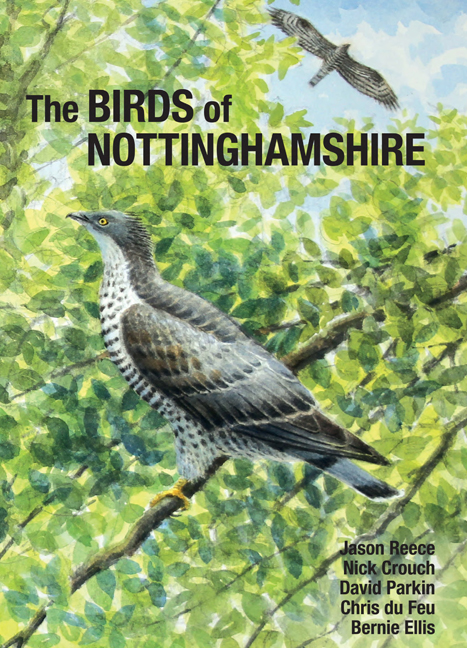Book contents
- Frontmatter
- Contents
- Foreword
- Acknowledgements
- Species sponsorship
- Introduction
- A history of bird recording in Nottinghamshire
- A description of Nottinghamshire and its bird habitats
- Methods
- Species accounts
- Additional Records 2014–2018
- Appendix: Additional and contentious species
- References
- Index
- Miscellaneous Endmatter
Methods
- Frontmatter
- Contents
- Foreword
- Acknowledgements
- Species sponsorship
- Introduction
- A history of bird recording in Nottinghamshire
- A description of Nottinghamshire and its bird habitats
- Methods
- Species accounts
- Additional Records 2014–2018
- Appendix: Additional and contentious species
- References
- Index
- Miscellaneous Endmatter
Summary
Introduction
The aim of this avifauna is to build up a comprehensive picture of the distribution, status and history of the birds of Nottinghamshire. Evidence has been drawn from a wide variety of sources, notably the data collected for the most recent BTO national Bird Atlas covering 2007–2011 (Balmer et al. 2013), hereafter referred to as the 2007–2011 Atlas. This has been supplemented by data from the Breeding Bird Survey (BBS) and Wetland Bird Survey (WeBS) running through to 2015 and from survey data from key sites such as Treswell Wood (for 1976–2015) and Center Parcs (for 1994–2010). So far as rarities and scarcities are concerned, officially accepted records are included to the end of 2013, with an attempt to place records in the county in a wider context. Notable additional records for the period 2014–2018 are dealt with in an appendix to the main list. The picture which therefore emerges is of the status of each species up to 2013 (or, for a few species, just beyond that date). Significantly, this provides an update of the status of each species in the forty years since the last county avifauna which dealt with records up to 1973 (Dobbs 1975).
Maps
The maps are based upon fieldwork undertaken by volunteers from the British Trust for Ornithology (BTO) and collated by BTO scientists. We are grateful both to the organisation for permission to use these data and to the hundreds of individuals involved with the surveys. There have been three breeding Atlases, with data collected in 1968–1972 (Sharrock 1976), 1988–1991 (Gibbons et al. 1993) and 2007–2011 (Balmer et al. 2013). There was also a winter Atlas with data collected through 1981/82–1983/84 (Lack 1986). The first breeding Atlas was based upon fieldwork undertaken within 10 km squares and was relatively ‘coarse grained’, as was the winter Atlas. Fieldwork for the 1988–1991 and 2007–2011 surveys were undertaken at ‘tetrad’ level (2 km by 2 km squares from the Ordnance Survey National Grid) and involved much more intensive fieldwork and so are rather more detailed in their results. All of Nottinghamshire's tetrads were surveyed in both winter and summer for the 2007–2011 Atlas. For the 1988–1991 Atlas (which only covered the summer months), just a subset of 320 tetrads were surveyed.
- Type
- Chapter
- Information
- The Birds of Nottinghamshire , pp. 49 - 54Publisher: Liverpool University PressPrint publication year: 2019



